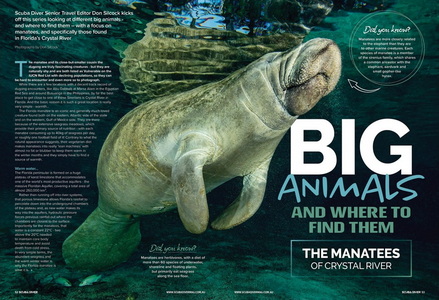The Florida Manatees of Crystal River… The manatee and its close but smaller cousin the dugong are truly fascinating creatures. But they are both naturally shy and listed as Endangered on the IUCN Red List with declining populations. So they can be hard to encounter and even more so to photograph.
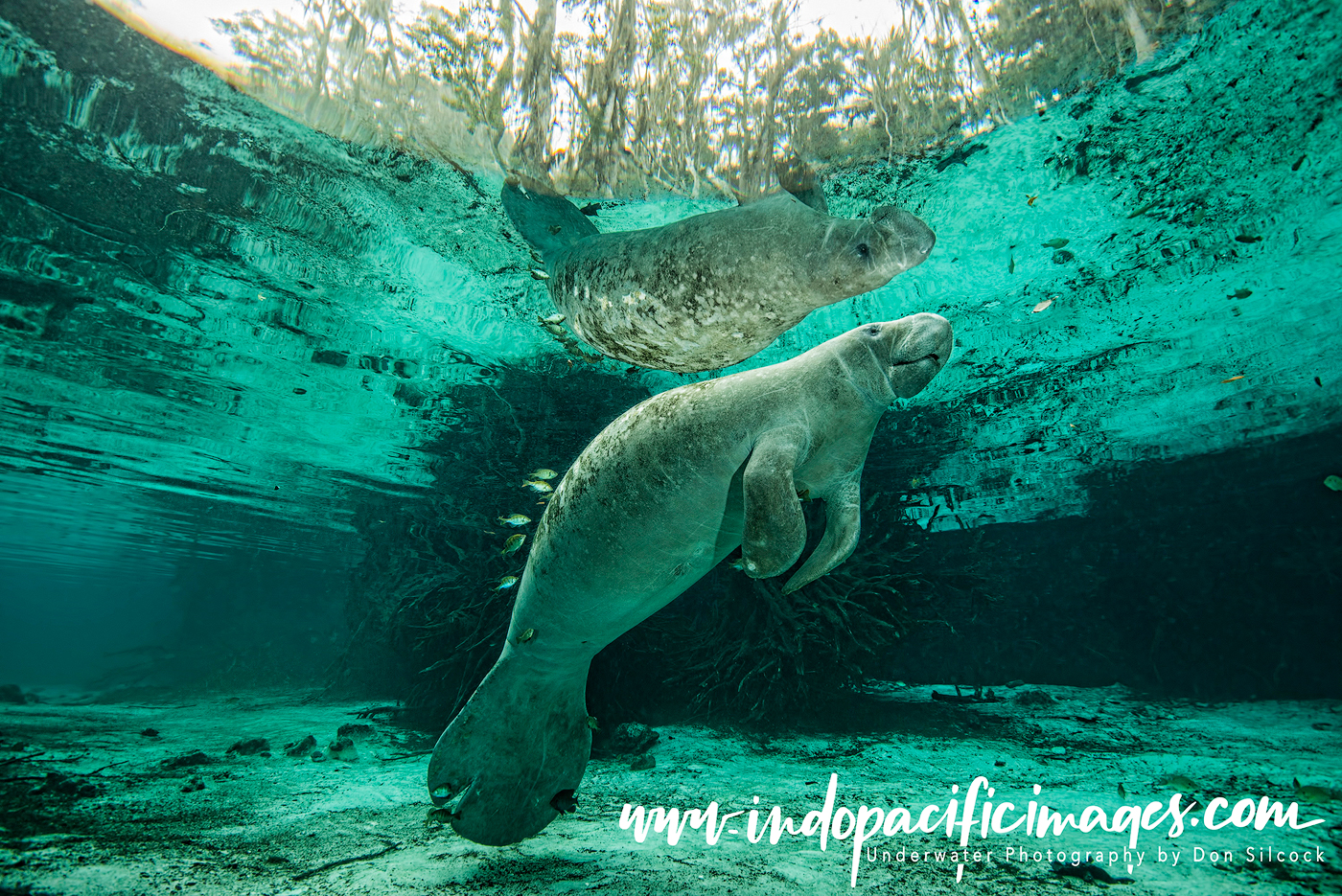
While there are a few locations with a decent track record of dugong encounters. Like Abu Dabbab at Marsa Alam in the Egyptian Red Sea and around Busuanga in the Philippines. By far the best place to get close to one of these Sirenians is the Crystal River in Florida.
And the basic reason it is such a great location is really very simple – warmth…
Florida Manatees of Crystal River
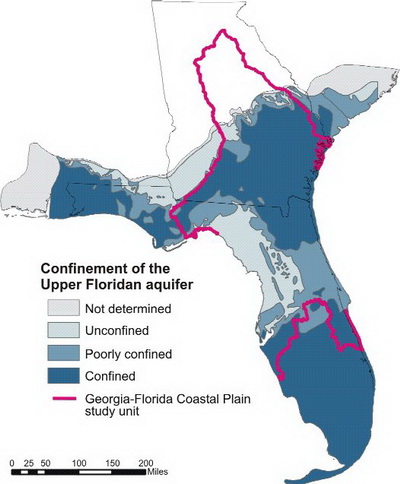
The Florida Manatee is an iconic and generally much-loved creature. They are found both on the eastern, Atlantic side of the state and on the western, Gulf of Mexico side. They are there because of the extensive sea-grass meadows, which provide their primary source of nutrition. With each manatee consuming up to 40kg of sea-grass per day, or roughly one football field of it!
Contrary to what the rotund appearance suggests… Their vegetarian diet makes manatees into really “lean machines”. With almost no fat or blubber to keep them warm in the winter months, they simply have to find a source of warmth!
The Florida peninsular is formed on a huge plateau of karst limestone. Which accommodates one of the world’s most productive aquifers – the massive Floridan Aquifer, covering a total area of almost 260,000 km².
Rather than running off into river systems, that porous limestone allows Florida’s rainfall to percolate down into the underground chambers of the plateau. And, as new water makes its way into the aquifers, hydraulic pressure forces previous rainfall out where the chambers are closest to the surface. Importantly for the manatees, that water is a constant 22°C. Two above the 20°C needed to maintain core body temperature and death from cold stress.
In very simple terms the abundant sea-grass and the warm winter water is why the Florida Manatee is what it is…
Kings Bay

Located on the Gulf of Mexico side of the Florida peninsula, Kings Bay has in an area of 2.5 km², around 100 warm water springs. 15 of which are significant “first magnitude” ones.
Combined they pump out some 110 million litres of 22°C water every day. Filling the bay and forming the head waters of the Crystal River which flows out into the Gulf of Mexico.
All of which makes the area prime real estate for the Florida Manatee and has been for a very long time… The difference now though is all the humans with their boats and canal-side residences.
If you are considering a trip to the Crystal River you need to understand that not all the locals are enamoured with their Sirenian winter visitors. Because of the access and speed restrictions introduced under legislation to make all of Florida a manatee refuge and sanctuary.
Swimming with the Florida Manatees of Crystal River
The Crystal River is the only location in the United States where tourists are allowed in the water with manatees. Because swimming with them was always a tourist drawcard and was “grandfathered” through the legislation. Something that would never be permitted if proposed today.
Manatee swimming is a significant employer in Crystal River. And pre-pandemic there were some 26 companies catering to the estimated 150,000 tourists in the season. So be aware that the chances of a quality encounter are pretty slim if you are there on a busy weekend. Or when one of the regular bus-loads of excited schoolkids and their moms arrive!
The Three Sisters Springs
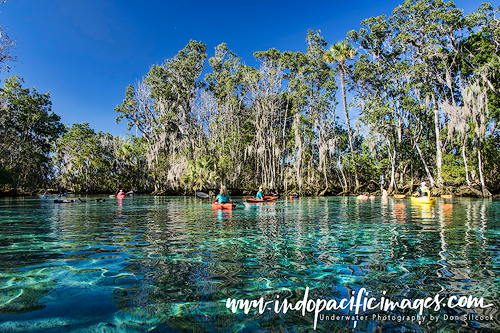
This set of three large springs is probably the most unique and inspiring place to see the Florida Manatee. Located in a wildlife refuge of some 58 acres of pristine vegetation. The Three Sisters is one of Florida’s last remaining urban springs.
Unlike the other springs in Kings Bay, at the Three Sisters those crystal-clear waters from the underground chambers do not merge with the darker waters of the canals and the bay until exiting the refuge. Which means that undisturbed the visibility is absolutely stunning. And creates a magnificent backdrop for the manatees that enter through the narrow channel to the canal system.
However… it is also open to the public. So what can seem like a tranquil haven if you are there alone, quickly turns in to thriving mass of assorted legs and torsos suspended from flotation sausages as the next party of excited tourists arrive!
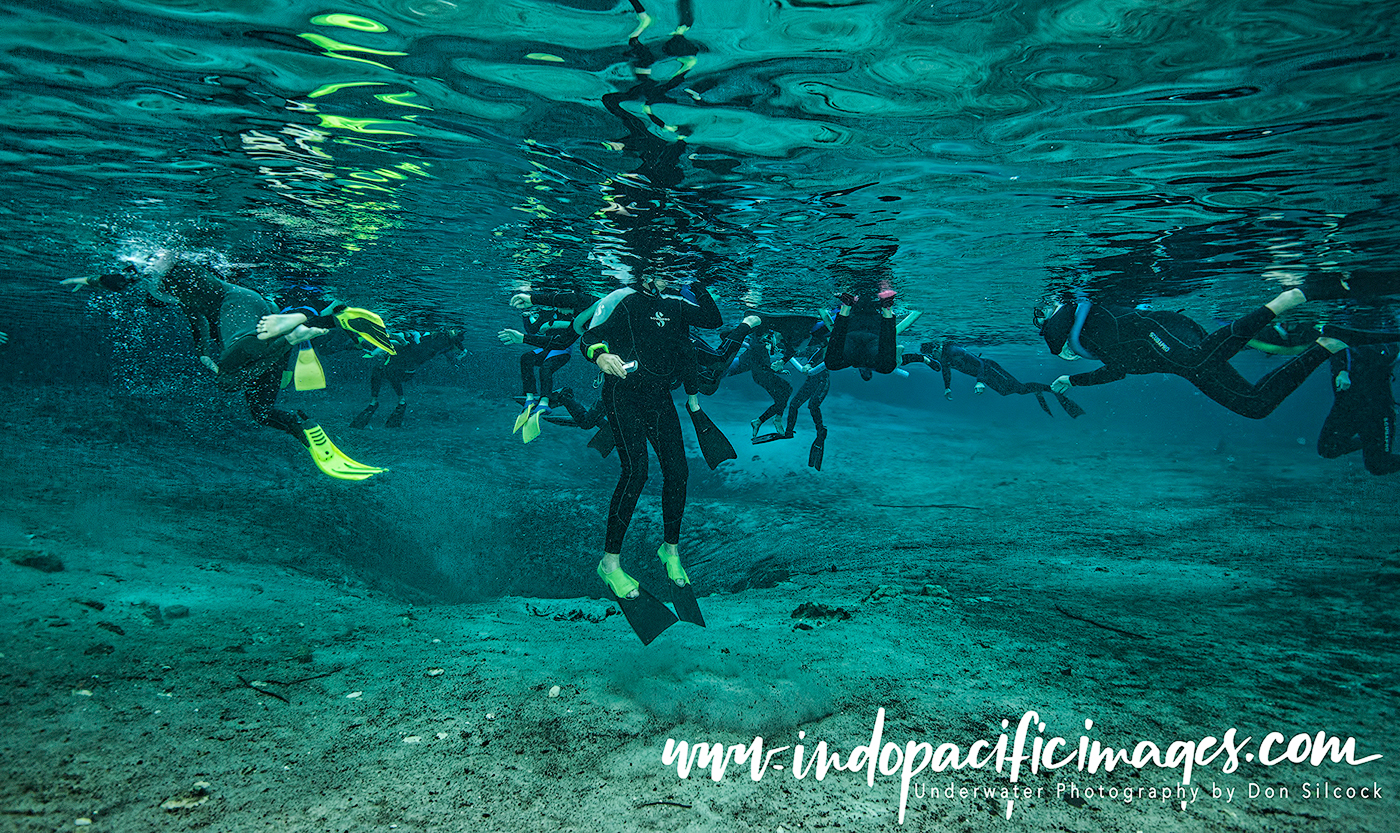
How to Get Good Images of the Florida Manatees of Crystal River
Obviously… you need to be there when the manatees are. Which means in winter from November to April. But the best chances are when the water is coldest, which typically means around mid-December to late January.
Don’t expect to get great images in 1-2 days. As there are just too many variables with the weather, water temperature and tourists. My first trip was 10 days and I needed them to achieve most of my objectives because of a couple of washed-out days.

What worked best was going out on an organised early morning trip to be at the Three Sisters by 07.00 when it opens. Sometimes that saw me there with just a few others. While at other times there would bea couple of dozen people. There is no way to plan, it’s all completely random.
Then in the afternoon I would rent a kayak and go back to the Three Sisters. Where, if I was lucky, I would find a spot to tie up the kayak and snorkel my way into the Springs. Late afternoon can be really excellent as most of the day tourists have departed. The water is gin-clear again and the manatees are calm and relaxed.

Special Use Permit
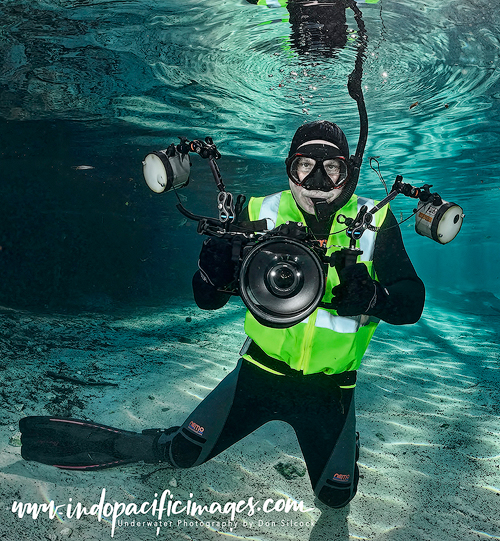
The best chance of good images is with a Special Use Permit from Fish and Wildlife Services. This requires watching an instructional video on how to behave and paying US$100. For which you are given a bright, numbered vest so the rangers can identify you… And are allowed to submerge rather than stay on the surface like all the other tourists.
Under no circumstances can you pursue the manatees and you must “observe passively”. But you soon learn when the sleeping manatees need to breath and submerge in position to capture them mid-water – all without harassing them.
Equipment
You need a wide-angle lens to capture the manatees as they are big animals. I found that a 16-35mm zoom on my Nikon D800 DSLR was a great combination. Strobes are no longer allowed unfortunately, which obviously impacts early morning shooting. But there is plenty of light in the afternoon and if it’s behind you all is good!
In Summary
My initial manatee trip was one of my first big animal trips and it taught me two basic things… Firstly it’s never easy to get good images and while preparation can get you in the zone, luck has a significant role to play… Secondly, when Lady Luck does shine on you and you get a great encounter it really is an incredible moment. These animals simply grace you with their presence.
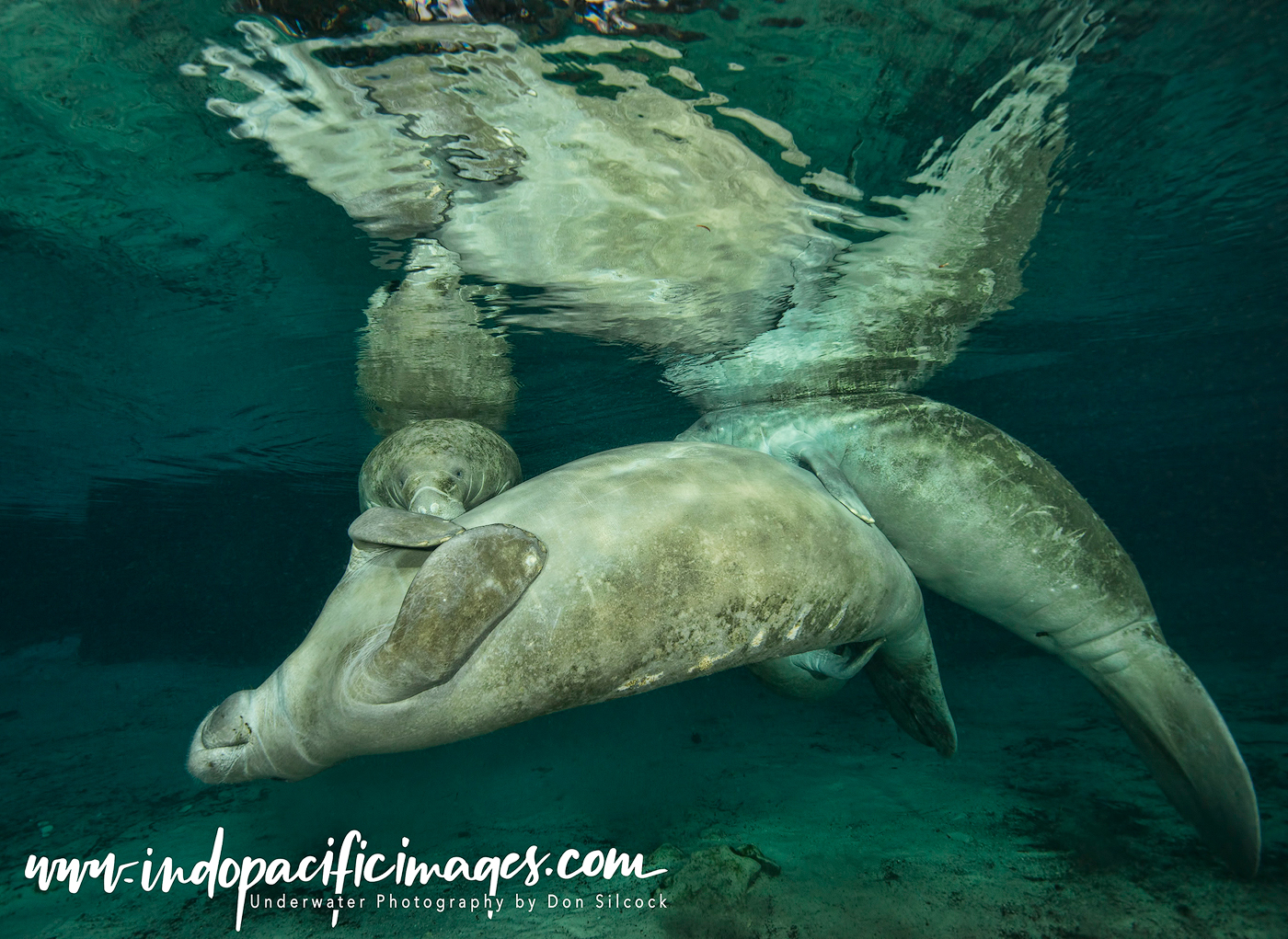
Scuba Diving ANZ Florida Manatees of Crystal River Article
Scuba Diver ANZ have published a four-page article of mine on the Florida Manatees of Crystal River as part of a regular series of “Big Animal” features and you can download a copy on the link.
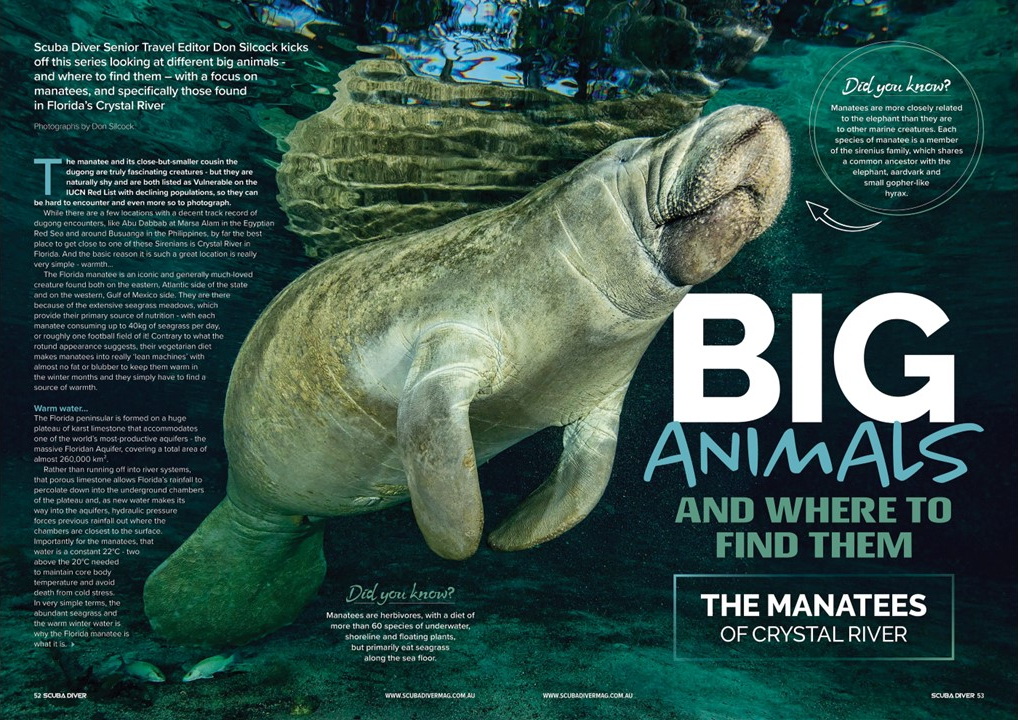
The Complete Guide to the Crystal River Manatees
If you would like to learn more about these truly special creatures check out the Complete Guide to the Crystal River Manatees!

